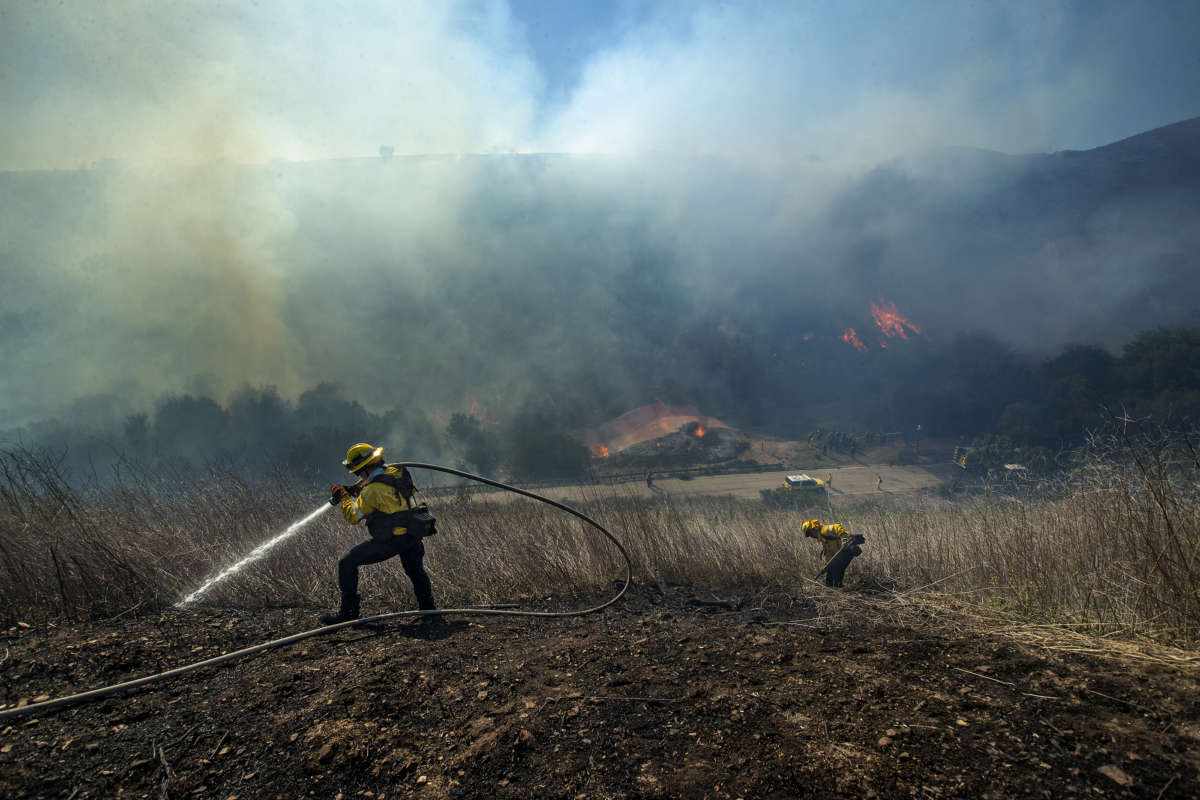Part of the Series
Covering Climate Now
Federal meteorologists and climate experts say the potential for another devastating wildfire season is higher than normal for much of the western United States, where a brutal heat wave shattered temperature records across multiple states this week.
Nearly 90 percent of the West is experiencing drought, increasing the amount of “fuel” for fires, such as dead trees and brush that is drying out up to a month ahead of schedule in many places, according to the latest climate update from the National Oceanic and Atmospheric Administration (NOAA). The past spring has been the warmest on record and the driest since 2006 in the lower 48 states.
Drought conditions have only intensified during the latest heat wave. More than 40 million people experienced triple-digit temperatures this week, straining power grids in Texas and California and prompting officials across the Southwest to warn the public against walking dogs on hot sidewalks and spending time outside during the day.
Wildfires are already burning across multiple states, including a massive 21,000-acre blaze in Montana, according to the U.S. Forest Service and news reports. With the start of summer right around the corner, the National Interagency Fire Center reported five new large fires on Thursday, bringing the current total to 33 fires burning across more than 400,000 acres in 10 western states.
Wildfires occur naturally and play an important role in certain ecosystems, especially in the West. However, climate change and the disruption of natural areas caused by human pollution and development have created conditions for widespread and devastatingly intense wildfires. A landmark 2016 study found that human-caused climate change is responsible for 55 percent of the increase in dryness that creates fuel for wildfires, more than doubling the amount of land burned across the western U.S. over the past three decades.
Last year, record-breaking summer temperatures, the fourth-highest level of drought on record and an unusual amount of dry lightning combined to create an “apocalyptic” fire season that saw 10.27 million acres of land burned, the most ever recorded, according to Yale Climate Connections. Millions of people in California, Oregon and Washington were forced to evacuate from cities large and small as huge wildfires raced across the landscape and sent enough smoke into the air to change atmospheric conditions across the nation.
Gina Palma, a fire meteorologist with the U.S. Department of Agriculture, said scientists are currently observing drought conditions that they would not normally see not in June, especially in the foothills of mountains and higher elevations across the West, increasing the likelihood of fires. Still, every fire needs a spark, and it remains to be seen whether lightening or fires started by people, for example, will spark the tinder available in brushy areas and dry forests and cause another intense wildfire season.
While there are a number of factors behind these tinderbox conditions, human-caused climate change is certainly one of them.
“We do expect in a warmer world to see more frequent and more intense wildfires, and also heat waves,” Palma told reporters on Thursday.
There is some good news: NOAA forecasters predict monsoon rains that were largely absent in recent years will return to New Mexico and Arizona later in the summer, relieving drought conditions and reducing the potential for significant wildfire outbreaks to normal levels. Palma said widespread drought has also prevented grass from growing that could dry out later in the summer and provide fuel for potential fires.
The potential for fire across most of Texas and the Midwest is expected to be normal or below normal this summer, although scientists warn that “normal” summer conditions could soon be a thing of the past as climate change threatens to become irreversible absent a widespread reduction in fossil fuel pollution.
According to NOAA, it’s still highly likely that many of the same areas across California, Utah, Oregon, Idaho, Washington and western Montana that suffered destructive and even deadly wildfires last year will see significant wildfire activity this summer.
Join us in defending the truth before it’s too late
The future of independent journalism is uncertain, and the consequences of losing it are too grave to ignore. To ensure Truthout remains safe, strong, and free, we need to raise $47,000 in the next 8 days. Every dollar raised goes directly toward the costs of producing news you can trust.
Please give what you can — because by supporting us with a tax-deductible donation, you’re not just preserving a source of news, you’re helping to safeguard what’s left of our democracy.
